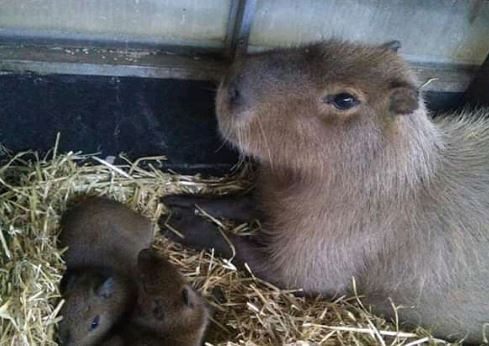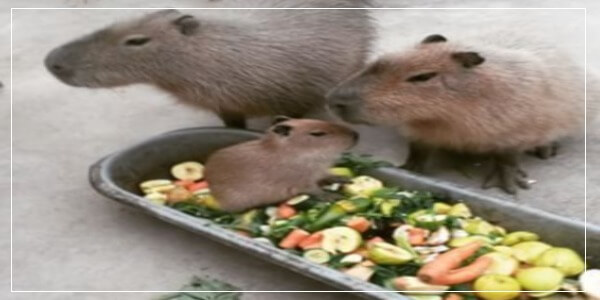While you marvel at the exceptional attitude of the capybara, some animals don’t care. All they see is a rodent they can eat. The capybara doesn’t share much in common with the pelican except the love of water. While the rodents enjoy a nice swim, the rivers are the pelican’s hunting ground.
Pelicans are carnivorous, and their main diet is fish, but they have been known to eat other animals, such as worms, crustaceans, and even other birds. They have an insatiable appetite and the guts to eat animals several times bigger than their mouth paths. Lol…
And they do that!
Pelicans are not picky waters; if they can swallow it, it is on the menu. Since pelicans and capybaras share the rivers, their paths would undoubtedly cross. Are capybaras also on the pelican’s menu, or can pelicans eat capybaras?
The answer is no. A Pelican might attempt to eat a capybara, but the truth is that this can’t happen.
RELATED: What Does Capybara Meat Taste Like?
Are Pelicans Aggressive To Capybaras?
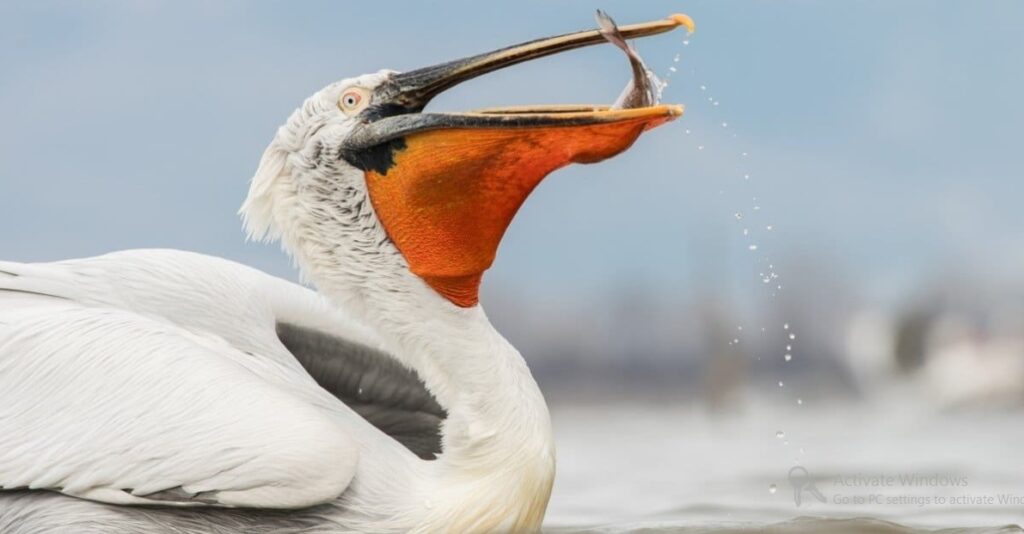
As I said, the Pelicans are ferocious eaters, and they would try to eat everything that crosses their path. While they are not particularly aggressive, they are not docile either.
They can be rowdy when scrambling for food, but they are calm when grooming, picking their feathers, and groping the rivers.
Pelicans are not aggressive to other animals except they want to rob them of fish or food. Capybaras are strictly vegetarian and would never eat fish; there is no reason for a Pelican to be aggressive to the capybara.
A recent video of a hilarious scene in a Japanese zoo has circulated on the internet. For whatever reason, the zoo had mixed its pelicans with several capybara families. The capybara is babies relaxing next to their mothers.
A Pelican suddenly pounces on the nearest young capybara and tries to swallow it. Even at such a tender age, the capybara was too big for the bird’s pouch. It slipped off its grip and took a few hops forward.
Doggedly, the bird went after it again and tried to scoop it into its mouth. Again, its beak couldn’t grip the rodent, nor can’t it cover it all. It slipped again, and the capybaras continued doing what it was.
After several attempts, the bird concedes defeat and lets the rodent be. It was hilarious to think the pelican, for specific, thought it could swallow a whole capybara. This underlines their inexhaustible appetite and quest for eating anything available, even if it’s several times larger than them.
Why Do Pelicans Try To Eat Other Animals?
They are carnivores. It is in their genes. They eat other animals for a living. Pelicans feed mainly on fish. Some species add crayfish or shellfish to their menu. They catch their prey with their beaks, having managed to push them towards shallow waters, using elaborate group fishing techniques.
Pelicans don’t care. As long as its food fits into their mouth, they will try to eat it. The pelican is a social bird whether a strong community instinct marks fishing, traveling, resting, or breeding, all of its activities.
A lone pelican will surely be a lost animal, injured or weakened by disease. Depending on the occupations and the time of year, the size of the gatherings varies from ten to a few thousand birds. There are two reasons for this social life.
The first, which is not specific to the species, is to improve safety. Faced with predators, unity is strength. A large and compact group has the edge over isolated birds.
Moreover, on the whole of a colony, there is always a proportion of birds on the alert, ready to point out the slightest danger to their fellows.
The second reason for them being social has to do with the concern to improve fishing conditions by identifying and collectively driving fish. This behavior often reaches great degrees of expression in the pelican.
But, whatever the reason for their formation, groups of pelicans are never organized according to a pre followed determined hierarchy. There is no dominant bird or dominated.
Each bird is content to integrate into the whole and to occupy a place in it as equal to its neighbors. At most, we can note a pre-eminence of adults over immature, especially on the fishing grounds.
The best prey goes to older pelicans, who manage to impose themselves thanks to their experience and superior knowledge.
Why Do Pelicans Try To Eat Capybaras?
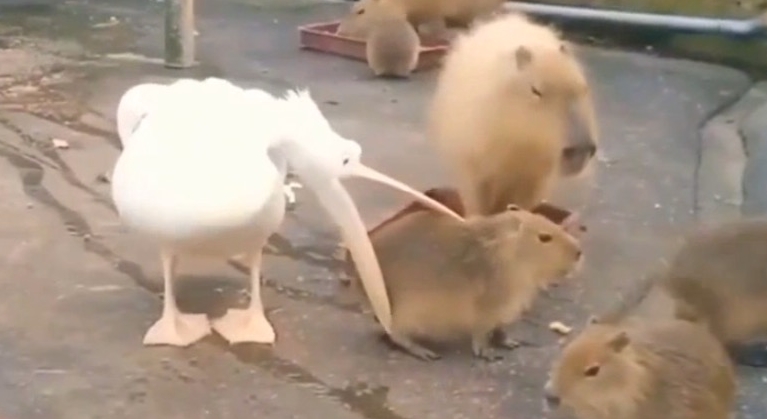
As I said before, pelicans are not picky carnivores. While most people are asking why the pelican asks why not. Why can’t they eat capybaras? If fellow carnivores, pumas, and jaguars find capybaras delicious, they must be, don’t you think?
Perhaps, there is a word on the carnivores’ dark web about how juicy sweet capybaras meat was, and dear old I-can-eat-everything bird wants to have a bite.
On a more serious note, Pelicans are ferocious eaters; they try to eat anything as long as it soothes them. So I’ll bet that bird in the viral video was trying his luck to see if capybaras can be eaten.
At 70kg weight and 5 feet in length, pelicans can’t possibly swallow a capybara. Perhaps they could get the job done if they were blessed with razor-sharp claws and teeth, like some of their carnivorous friends.
But the pelican’s beak is not even sharp. It was designed to scoop fish and not tear flesh.
Why Do Pelicans Like Capybaras?
Everyone loves the capybara for their friendliness! The capybara is tolerant and peaceful with every animal, and they won’t get violent unless attacked.
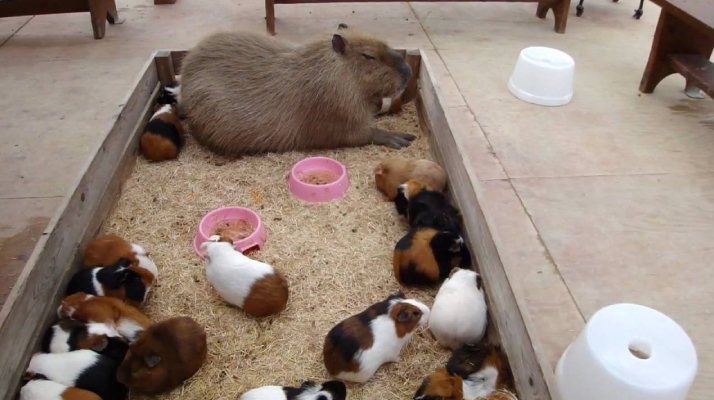
Although some animals, such as jaguars, are predators of the capybara, the pelican is not on the list of animals that hate the rodent.
While we can say they like them (they are not fish, after all), they also hate them. They do like to be around rodents, though. Perhaps it is the shared love of water or the fact that the peaceful capybara aura has rubbed off on them too.
Why Do The Pelicans Follow Capybaras?
Pelicans follow capybaras because the rodents always follow the water. The birds know where there is water; there is fish. So it’s a three-stepped pathway. Capybara loves water, and in the water, there is fish.
Do Capybaras Eat Pelicans?
No!
What would you ask that question? If you knew what a capybara was, you would see they can’t eat a Pelican.
Capybaras are herbivores, picky herbivores, for that matter. They won’t eat leaves they don’t like or eat worms. They are precise about their food, so specific it’s almost robotic, as if they are running on a peculiar genetic code.
There is nothing in common between the diets of the two animals. While capybaras are herbivorous, pelicans are not. Pelicans love feeding on fish, which it usually catches in shallow water close to the surface.
It prefers social fish goes to gregarious fish moving in schools and, therefore, easier to capture. But they never refuse any isolated prey either.
The pelican can swallow large fish, such as carp, weighing 1.85 kg. The daily amount for an adult is estimated at 900-1200 g. This quantity, however, is higher when the adult is young.
That’s a lot of fish. If capybaras were fish, they might be attractive to the pelicans. The only thing common to their diets is the sheer amount of food they consume daily. They are not in each other’s direct food chain.
Why Do Capybaras Not Hurt Pelicans?
A Capybara doesn’t hurt any animal. It’s docile and harmless. The only thing it can threaten is the vegetation they religiously consume.
They might have sharp teeth, but it is more for defense than offense. They never use it unless they need to.
So as long as the pelican is not hurting them in any way, capybaras are fantastic and would not attack (or defend, as the case may be. Capybaras seldom attack; they are docile animals, remember?)
The bird can peck or climb on them and play with their fur; capybaras don’t care.
Can Pelicans and Capybaras Live Together?
Absolutely. Capybaras can live with Pelicans without any hassle. Here are some reasons why the pelican can co-exist with the capybara:
- Different Diets: They don’t share the same food, is they won’t be in direct competition for food. Capybaras don’t eat fish, and pelican doesn’t eat grass.
- Water: Both animals love water and can’t live without it. Their reasons are different, capybaras swim, and pelicans hunt.
- Friendly Neighbours: They are not dangerous to each other. Pelicans, other than fooling around, can’t seem possible to swallow a capybara, and the bird is not on the rodent’s menu either.
They are two different animals, harmless to each other. Some zoos house them together, or at least they have access to the pool area at the same time. Now house large cats and the capybara and observe what would happen.
Can A Pelican Be a Pet?
Yes, but I don’t think that is a good idea. First, pelicans are huge (have you seen the size of those things!), and catering for such big birds will be a handful.
Secondly, pelicans are social animals. Pulling them out of the flock won’t help their well-being. They can get depressed or sick if they lose their flock and become house pets.
Of course, almost every animal can be trained to do this or that, and you can prepare your pet pelican to be an excellent house pet. But the best is to let the bird be.
Aside from that, it is illegal to house some pets in some cities without a license. The same goes for a capybara; you need a license to adopt it as a pet. Getting a Pelican as a pet is something you must consider seriously.
TRENDING: Where Is It Legal To Own A Capybara Pet In The US?
Are Pelicans Pests To Fishermen?
Pelicans are adorable to tourists but a menace to fishermen. Why? With their long wingspan, spotlessly white feathers, and weird beaks, they are wondrous to tourists who may have never seen them so close.
Pelicans are not afraid of humans and would come close if you have treats to offer. Hold a fish, and pelicans will swim you. This makes their presence a common occurrence at beaches and anywhere fishes gather.
Speaking of schools of fish, fishermen don’t like pelicans. The reason is apparent; there is a conflict of interest. The fisherman and the pelican want the same thing, the fish.
After all the baiting, waiting, and pulling nets to the boats, which fisherman would want all his effort wasted by a wild bird? So they chase them away from the catch. You need not encourage them by giving them scraps. Pelican moves in flocks, encouraging one and the others to come too.
There is a case in Senegal, though, in the region of M’Bour, south of Dakar, when men and pelicans struck a mutualist relationship. A large colony of pelicans arrived a few years ago; it has installed its nests in the trees of a village inland in the middle of the Serer country.
When returning from the shore where they went fishing, large birds often drop some of the many fish they carry in their beaks to feed their young.
Fishermen then hasten to pick them up and sell them in the neighboring villages. The men, too far from the sea to go fishing themselves, are thus supplied with fresh fish thanks to the pelicans.
In exchange for these involuntary “gifts,” the pelicans receive absolute protection from the villagers who watch over their nests.
Conclusion
So what have we learned from this tale? Let’s recap.
Capybaras and pelicans are amazing animals. They have things in common, like being social animals and loving to be around water. Like their general attitude, Capybaras are not unfazed to be around pelicans as they share the same riverbank in one big nature and circle of life.
Capybaras and pelicans are ferocious eaters, but they feed on different things. Capybaras are herbivores, while pelicans eat fish. Pelicans try to eat capybaras, but they are too big to swallow
Getting a Pelican as a pet is expensive, stressful, and probably detrimental to the bird itself. Pelicans are adorable to tourists but a pain in the butt for fishermen.

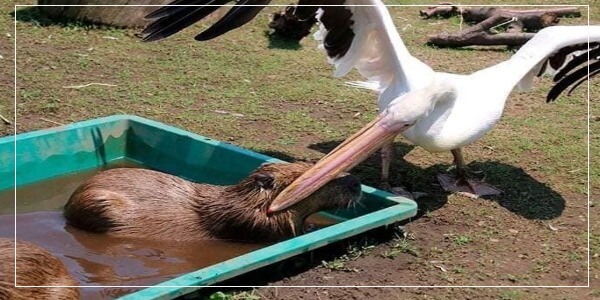
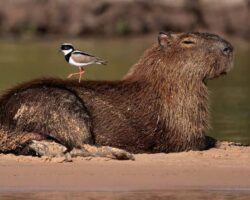


![Capybara Meat And Its Culinary Uses - [Every You Should Know] Capybara Meat & Culinary Uses](https://capybaratips.com/wp-content/uploads/2023/03/Capybara-meat-250x200.webp)


